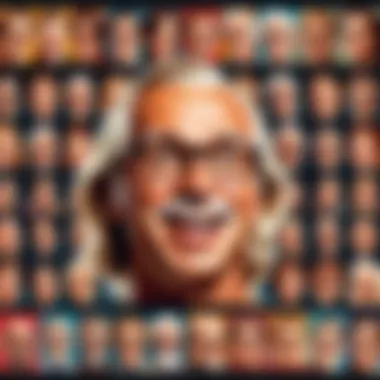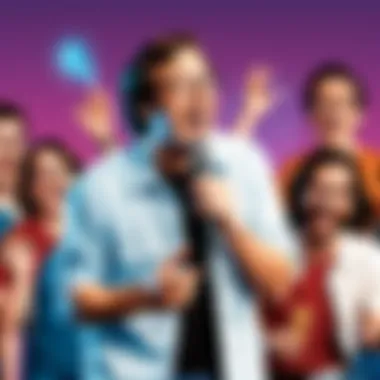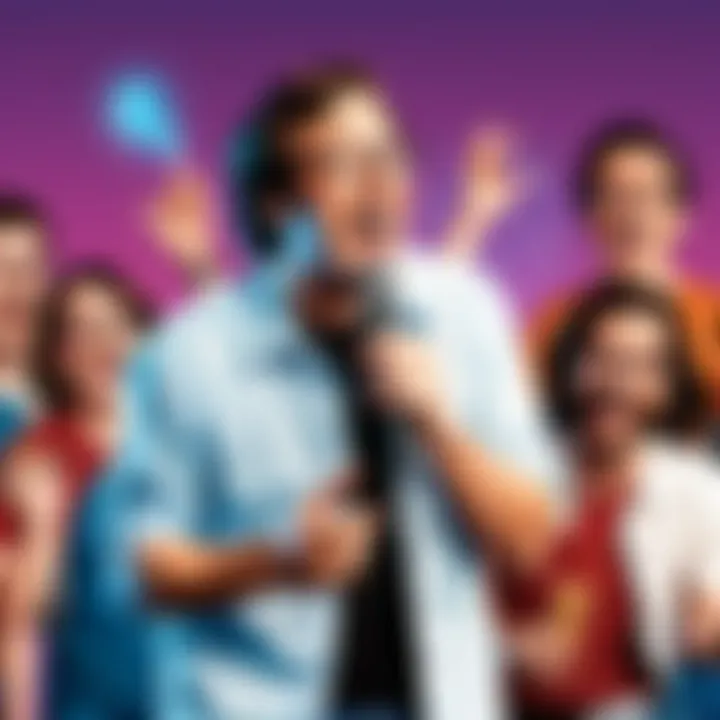Exploring the Depths of American Humor Culture
Intro
American humor is a vibrant and multifaceted element of culture. It is woven into the fabric of everyday life, reflecting the values, struggles, and complexities of society at large. This section serves as a gateway to understanding the intrinsic nuances of humor embedded in American culture.
As we delve into this exploration, consider how humor serves not just as entertainment but also as a tool for social commentary. It acts as a mirror, reflecting societal norms and changes while allowing individuals to bond over shared experiences or differing perspectives.
American humor has deep historical roots, influenced by various social movements and milestones. From vaudeville shows in the early 20th century to the rise of stand-up comedy as a respected art form, the evolution is striking. Key figures, such as Mark Twain, Lucille Ball, and more contemporarily, Dave Chappelle, have shaped the humor landscape, each bringing unique perspectives and styles.
This exploration aims to unlock the layers of styles, genres, and notable personas that dedicate their talents to this craft — summoning laughter while provoking thought. Join us as we analyze how humor manifests in movies, television, and social media, but also how it ricochets through historical events and cultural shifts, shaping American identity.
Historical Evolution of American Humor
Understanding the evolution of American humor is akin to walking down a historical timeline; each period reflects the prevailing societal attitudes and innovations affecting the country. The colonial era relied heavily on satire and political pamphlets, responding to, and often critiquing, the British monarchy and policies.
With the advent of mass media in the 20th century, humor began to diversify significantly. The Great Depression gave rise to slapstick and physical comedy, as seen in figures like Charlie Chaplin and Buster Keaton, who provided relief through laughter during hard times. Later, television brought comedians like Johnny Carson and Garfield comics into American homes, making humor accessible and personal.
The Role of Societal Influences
Humor is never created in a vacuum — it is profoundly influenced by societal dynamics. Several factors contribute to how humor evolves:
- Cultural Shifts: Changes in societal values around race, gender, and politics often reshape comedic material, reflecting contemporary conversations.
- Current Events: Many comedians lean into current events as a fertile ground for content, utilizing humor to process difficulties or absurdities in real life.
- Technology: The internet has revolutionized how humor spreads. Platforms like Reddit and Twitter see jokes circulate at lightning speed, morphing and reshaping along the way.
"Humor is an affirmation of life, even in the face of adversity. It connects us to one another and puts the struggles of the day into perspective."
As we move through different comedic styles and notable figures in the comedy world, we’ll discover the unique characteristics that define various genres and what they reveal about American society and identity.
Cultural Commentary through Comedy
At its best, humor provides a critical lens through which to view society. Comedians often become cultural commentators, poking fun at social norms, pointing out contradictions, and challenging the status quo. This commentary is crucial in times of upheaval, as humor helps to deconstruct the norms that may no longer serve society.
Comedians are often at the forefront of cultural conversations, from the subversive comedy of George Carlin to the current landscape of political satire showcased by shows like Saturday Night Live and The Daily Show. Each of these has played a role in engaging the audience with pressing societal issues, making difficult conversations digestible.
Closure
In summary, American humor serves as an intricate reflection of its culture and history. Each joke and comedic performance is a piece of a larger narrative that showcases collective identity while also providing a critique of prevailing conditions. Throughout this journey into the past, present, and future of American humor, we will see how laughter can bridge the divides, providing a communal experience while sparking introspection and dialogue.
The Nature of Humor
Humor stands as a pillar of American culture, providing not just entertainment but also a buffer against the stresses of everyday life. From the daily grind to complex social issues, laughter offers a brief escape and a shared experience among people of varied backgrounds. Understanding the nature of humor is essential because it reveals how individuals relate to one another, navigate societal norms, and articulate dissent or camaraderie through comedy.
Defining Humor
At its core, humor is subjective, often varying drastically from person to person. It can be defined as the quality of being amusing or entertaining. But really, humor doesn't just sit on the surface; it bubbles up from deeper waters, shaped by context and timing. For example, what tickles the funny bone in the bustling streets of New York might fall flat in a quieter corner of the Midwest. In essence, humor functions as a mirror reflecting cultural values, beliefs, and even the absurdities of life.
To explore this further, consider these forms of humor:
- Wordplay: Jokes that rely on the clever use of language, such as puns.
- Observational Comedy: Relatable anecdotes about daily life experiences.
- Slapstick: Physical comedy that relies on exaggerated actions and situations.
- Satire: A biting commentary on contemporary social issues, often calling attention to contradictions.
Each type spins its own thread in the intricate fabric of humor, showcasing how diverse American comedy truly is. From the dry humor found in The Office to the outrageous antics of Saturday Night Live, humor adapts and morphs, reflecting the society from which it emerges.
The Psychology Behind Laughter
Laughter itself is rooted in psychology, serving multiple roles in our lives. Biologically, it triggers the release of endorphins, promoting feelings of happiness and connection. Psychologists note that laughter often serves as a social glue; it fosters bonds between folks, easing tensions and facilitating communication.
Moreover, humor can serve as a coping mechanism. In times of strife, such as during the COVID-19 pandemic, people turned to humor as a way to navigate their fears and challenges. Laughing about their struggles helped many find solidarity amidst isolation.
Consider this: when we laugh at something absurd, we are not merely finding it funny, but also processing our outrage or confusion in a palatable manner. Such reactions help maintain emotional balance while addressing serious subjects.
"Laughter is a language of empathy. It allows us to breach gaps, soothe tensions, and recognize our shared human experience, even when faced with life's prickliest issues."
In summary, the nature of humor is multifaceted and serves as a rich area of study. By defining humor and delving into the psychological aspects behind laughter, one can appreciate the intricate ways these elements intermingle, ultimately shaping the identity of American comedy.
Historical Context of American Humor
Understanding the historical context of American humor is crucial to grasping its evolution and impact on society. Humor is not merely entertainment; it often serves as a mirror reflecting societal norms, politics, and cultural changes. From its early roots to modern adaptations, the pathways of American humor reveal how it has been shaped by, and has shaped, the American landscape.
Early Influences


The origins of American humor can be traced back to the early settlers who brought their traditions and comedic styles with them. From the satirical ballads of the colonial period to the witty tales of Mark Twain, early American humor was characterized by a blend of European influences and new, indigenous experiences.
Key Elements of Early Influence:
- Satire: Important in critiquing societal norms and government policies, often providing a voice to the common folk.
- Regional Variability: Different regions brought distinct styles; for instance, humor in the Northeast often differed starkly from that in the South.
These early influences laid the groundwork for various humor traditions that would emerge, affecting how comedy was perceived and practiced in America.
Vaudeville and Its Legacy
Vaudeville emerged in the late 19th century as a popular form of entertainment, combining various acts, including music, dance, and comedy. This variety show format was crucial in spreading humor across the nation, as diverse performers showcased their talents.
Legacy of Vaudeville:
- Broad Appeal: Vaudeville provided a platform for performers of different backgrounds to reach broader audiences, which significantly influenced the democratization of humor.
- Talent Development: Many famous comedians, such as Charlie Chaplin and Buster Keaton, honed their skills within this vibrant scene, paving the way for future generations.
The legacy of vaudeville echoes in today's comedy clubs and television shows, creating a sense of continuity in American humor.
Stand-Up Comedy Evolution
Stand-up comedy, which gained popularity mid-20th century, became a vital element of American humor. Unlike earlier forms that often relied on scripted performances, stand-up allowed comedians to interact directly with audiences, making the experience more personal and dynamic.
Evolution Aspects:
- Social Commentary: Comedians like Lenny Bruce and Richard Pryor not only made people laugh but also tackled serious issues like race, politics, and sexuality, integrating humor with profound societal reflections.
- Diversity in Styles: From one-liners to storytelling, the styles of stand-up have evolved, showcasing how varied humor can be. Comedians are increasingly drawing from their own experiences, thus enriching the comedy landscape.
Humor can be the first step to understanding complex issues, breaking down barriers that otherwise remain high.
Modern Forms of American Comedy
American humor has taken a variety of forms throughout the years, adapting to changing cultural landscapes and technological advancements. By delving into modern forms of comedy, one can appreciate how humor serves as a barometer for societal shifts. In the contemporary age, the ways people consume and create comedy have revolutionized, providing ample opportunities for expression and connection. Whether it’s through television, film, or the rapidly changing realm of the internet, these forms of comedy allow for diverse voices to emerge and engage with audiences in profound ways.
Television Sitcoms
Television sitcoms stand as a crucial pillar in American humor. Shows like Friends, The Office, and Parks and Recreation weave humor into everyday life, allowing audiences to laugh at situations that resonate with their own experiences. Sitcoms often explore personal relationships and social norms, making light of often heavy topics. The format often includes recurring themes, catchphrases, and character development that enable viewers to build connections with the characters over time.
In the realm of social commentary, sitcoms manage to address pressing issues with levity. For instance, Modern Family touches on dynamics of a non-traditional family setup with humor while challenging societal norms.
"Comedy is the art of making people laugh without making them think too much."
— Unknown
By juxtaposing comedic elements with real-life situations, these shows serve to validate the everyday struggles of their viewers, thus creating a sense of belonging among audiences. Sitcoms will continue to influence new generations, shaping how humor reflects and engages societal attitudes.
Cinematic Humor
Cinematic humor offers another lens through which American comedy is expressed. Films have a longer format to create relationships with characters and develop plots around humor. Classics like Airplane! and Groundhog Day showcase how cleverly crafted scripts and timing can render unforgettable comedic moments. While some films rely heavily on slapstick comedy, others tap into clever wordplay and situational irony to entertain.
Moreover, the interaction between comedy and other genres reveal another layer of humor’s versatility. Comedies like Get Out ingeniously infuse satire and horror, creating a unique narrative designed to elicit both fear and laughter. This blend not only entertains but also provokes thought, illustrating how cinema can serve varied purposes beyond mere amusement.
Internet Memes and Viral Content
In the landscape of modern American humor, internet memes and viral content have fostered an unprecedented level of participatory comedy. Platforms like Reddit and Facebook have birthed a new wave of creators who share and remix jokes and situations. The accessibility and speed of these mediums mean that a humorous image or video can achieve viral status overnight.
Memes have adapted to become the digital language of humor, bridging gaps across generations. They often reflect current events, trends, and even deep-rooted cultural issues in a concise manner. For instance, the proliferation of memes regarding political situations allows individuals to engage with complex matters often cloaked in a veil of humor.
Furthermore, the mobility of digital humor means that audiences engage with content on a global scale, reinforcing that humor can transcend barriers. This interconnectedness fosters a collective experience, which resonates, laughs, and reflects upon shared experiences and contexts.
In summary, modern forms of American comedy have fundamentally altered how humor is created, consumed, and understood. These forms are vital to better comprehend cultural perceptions and communal sentiments, resonating through generations.
Key Figures in American Comedy
When one delves into the world of American humor, it's impossible to overlook the towering figures who have shaped its course. These comedians are more than just entertainers; they serve as cultural barometers, reflecting the society around them. Their contributions have not only left an indelible mark on the comedy landscape but also on the broader cultural narrative of the United States. In this section, we will explore two distinct eras of comedic influence—Influential Comedians of the Past and Contemporary Icons—and analyze the significance of their work.
Influential Comedians of the Past
The foundations of American humor were laid by a series of trailblazers, each of whom brought a unique flavor to the stage. Figures such as Charlie Chaplin and mark twain showcased both wit and satire, laying groundwork that would come to influence countless others.
Consider the antics of Chaplin’s Little Tramp—a character that embodied the struggles of the working class during the early 20th century. His silent films went beyond mere comedy; they were commentaries on the societal challenges of his time. Through physical comedy and poignant narratives, he connected with audiences on a level that transcended words. Similarly, Mark Twain’s sharp insights into human nature reflected the complexities of American life, as he blended humor with profound social critique. His clever use of dialect and story-driven humor made literary contributions that remain relevant today.
As the years went by, comedians like Lenny Bruce began to push boundaries even further. Bruce’s willingness to tackle taboo subjects and expose societal hypocrisy paved the way for future generations, demonstrating that comedy could be both an art form and a radical act of defiance. This legacy of challenging the norms continues to resonate today, reminding us that humor often strolls hand in hand with critique.


Contemporary Icons
Fast forward to the present, and we see a new breed of comedians standing on the shoulders of those pioneers. Names like Dave Chappelle and Amy Schumer have emerged as key figures, once again reshaping what American comedy looks like.
Dave Chappelle, in particular, has carved out a niche that masterfully blends social commentary with humor. His comedy specials often address race relations, identity, and politics, all while maintaining an undertone of absurdity. This deftly walked line between laughter and introspection allows audiences to reflect on serious issues while simultaneously enjoying the comedic experience. Chappelle's unique brilliance lies in his ability to make us think—often with a wry smile—about the complexities of our lives.
On the other hand, Amy Schumer uses her platform to address women’s issues, body image, and relationships. Her candid storytelling brings a fresh perspective to topics historically seen as taboo in comedy. By intertwining humor with personal anecdotes, she invites her audience to share in her experiences, fostering a sense of connection that is both relatable and empowering.
Moreover, the digital age has birthed new personalities, transforming how humor reaches us. Comedians who emerged from platforms like YouTube and Instagram, such as Kevin Hart, are redefining the gatekeepers of comedy. They bring a diverse range of voices and experiences directly to audiences, allowing comedy to reflect the rapidly changing cultural landscape.
The Role of Satire and Parody
Satire and parody hold a crucial place in the landscape of American humor, serving as both reflections and critiques of society. These forms of comedy allow individuals to dissect prevailing beliefs and norms, all while cloaked in wit and derision. Through satire, complex ideas are transformed into digestible bits of humor, exposing the absurdities that often lie just beneath the surface of American life. This function has profound implications, particularly in an era where voices are increasingly polarized. With parody, a similar mechanism is at play: by mimicking the styles of cultural artifacts, it prompts audiences to reconsider the very constructs they consume.
The benefits of this dual approach are manifold. It not only reinforces community bonds through shared laughter, but it also educates audiences on significant cultural or political issues. In many ways, satire can serve as a catalyst for change, nudging viewers to rethink the status quo. The deft use of humor in these critiques makes it easier for often uncomfortable topics to be approached without the heavy burden of solemnity.
When examining satire and parody, it's essential to consider how they require a delicate balance. Missteps can lead to misunderstanding, thus the intent behind the humor must be clear. There can be a fine line between cheeky criticism and unintentional offense, something contemporary comedians often grapple with in their work.
"Humor is a trampoline. It has to be anchored firmly in reality, but can catapult the thinker into perspectives unseen."
This important aspect of the role of satire and parody reveals much about the sociology of comedy itself, serving as a lens through which we analyze collective anxieties and aspirations.
Political Satire
Political satire has emerged as a potent form of commentary in the United States, especially during election cycles and times of social unrest. Shows like "Saturday Night Live" and "The Daily Show" have carved out significant spaces for this kind of humor, often transforming the absurdities of current events into easily digestible segments. It harnesses the power of humor to engage audiences about issues they might otherwise overlook in more traditional discussions.
The effectiveness of political satire lies in its ability to simplify complex political landscapes. For instance, Jon Stewart and Stephen Colbert might take heavy issues like healthcare or immigration policy and translate them into formats that resonate with the general public. This not only entertains but also prompts viewers to reflect critically on the motivations and consequences behind political actions.
Moreover, political satire has evolved with the advent of social media. Platforms such as Twitter and TikTok have given birth to rapid-fire responses to current events, exemplifying a real-time critique landscape.
- No longer confined to traditional media, political satire now thrives as a viral phenomenon.
- Audiences can expect up-to-the-minute takes that reflect public sentiment, allowing for a vibrant dialogue to unfold.
The risks associated with this type of humor, however, cannot be ignored. As political ideologies become more entrenched, satire can inadvertently amplify divisions rather than bridge them. Therefore, comedians carry the weight of responsibility, ensuring that their humor sheds light rather than creates darkness.
Cultural Parody
Cultural parody, on the other hand, takes aim at various aspects of society—be it fashion, lifestyle, or even subcultures. This form of humor shines a spotlight on the idiosyncratic behaviors that define particular groups, often using exaggeration and imitation to expose the silliness inherent in them. Highlights of cultural parody are seen in works like "Weird Al" Yankovic's song parodies, which encapsulate mainstream music tropes while providing insightful commentary on popular culture.
This specific humor reflects the audience's own experiences while allowing them to laugh at the quirks of both themselves and others. Consider how a Southern BBQ culture might be parodied to highlight its deep-rooted traditions and eccentricities, providing both amusement and critique.
Cultural parody also has a soothing effect in a diverse landscape, offering pathways to discuss sensitive topics. By leveraging shared cultural symbols, it fosters a sense of community even amid the juiciest social tensions.
To wrap it up, the significance of both political satire and cultural parody in American humor reflects the ongoing evolution of societal values and collective consciousness. They bridge gaps, provoke thought, and most importantly, open discourse that can be both entertaining and enlightening.
Regional Variations in Humor
Understanding regional variations in American humor is akin to unveiling the diverse tapestries that form the cultural quilt of the United States. Each region brings its unique flavor, colored by history, demographics, and local phenomena that shape what is deemed funny. This localized humor often serves as a mirror—reflecting the values, beliefs, and nuances of the people living there. Gaining insight into these variations is not merely an exploration of comedy styles; it opens a window into the heart and soul of America itself.
East Coast vs. West Coast Comedy
The East Coast and West Coast represent two distinct realms of American humor. East Coast humor, often characterized as edgy and quick-witted, draws heavily from urban life. It's the birthplace of many iconic stand-up comedians, whose jokes frequently revolve around the hustle and bustle of city living. This style might resonate with phrases like "cut to the chase"—a reflection of the fast-paced lifestyle that saturates New York City scenes.
On the flip side, West Coast comedy tends to embrace a more laid-back, often absurdist style, influenced by the cultural and entertainment industries of places like Los Angeles. People find entertainment in the light-heartedness of their realities. Consider the classic California surfer lingo or the quirky characters from shows set against palm tree backdrops; these comedy forms often borrow from an easygoing ethos that contrasts sharply with their East Coast counterparts.
Southern Humor Traditions
Southern humor is steeped in storytelling, and it's often infused with a sense of warmth and communal spirit. Think of the slow drawl of a Southern belle spinning a yarn about family antics or the peculiarities of life in small towns. This humor generally relies on irony and satire, often painting a vivid picture of the region's quirks and eccentricities. As they say down South, "Bless your heart"; this phrase can convey everything from genuine sympathy to a patronizing laugh, illustrating the richness of context in Southern humor.
Southern humor has also made its way into modern platforms, where websites like Facebook and Reddit play host to memes that echo the distinct qualities of Southern life, allowing these traditions to spread far beyond regional borders.
Midwestern Wit
Midwestern humor often prides itself on subtlety and sarcasm, wrapped in a friendly facade. The notion of making light of oneself or the situation holds a special place here. One hallmark is its self-deprecating nature; Midwesterners will often poke fun at their polite demeanor, using humor to create intimacy while disarming awkward situations. A classic joke might involve a farmer discussing his corn crop as if it’s the most thrilling topic, leading to chuckles about the mundanity of life.
One might say, "You know you’re in the Midwest when the highlight of your week is a tractor pull!" This simplicity and charm elicit laughter while endearing the speaker to their audience.
"Humor isn’t just a matter of punchlines; it’s a cultural glue that binds diverse communities, painting a fuller picture of our shared American experience."


Each region’s style of humor showcases not only individual identity but also how deeply culture and societal context entwine with comedy. As comedy continues to evolve, understanding these regional nuances enhances our appreciation of the art form, bridging gaps and building connections across the varied landscapes of American life.
Challenges and Critiques of Humor
The landscape of humor is not merely a playground of laughter and giggles; it's a battleground of ideas, perceptions, and sometimes controversy. An exploration of the challenges and critiques surrounding humor highlights how this form of expression can reveal much about societal norms, fears, and ideologies. As American humor evolves, it simultaneously grapples with external pressures such as censorship and internal debates about what constitutes acceptable humor.
Understanding these challenges allows us to appreciate not only the art of comedy but also its societal implications. At its core, humor serves to unite people, but it may also inadvertently divide or offend. Recognizing these dimensions encourages a deeper discussion about how humor can be both a reflective and refractive lens on cultural values. Without interrogating these complexities, we risk oversimplifying the narrative of humor in American culture.
Censorship in Comedy
Censorship within comedy presents a significant challenge. It poses the question: To what extent should comedic expression be curbed in the name of decency or respect?
Historically, comedians have walked a fine line; they often use their platform to push boundaries and provoke thought. However, as social media turns up the volume on dissenting voices, many jokes that once elicited laughter are now scrutinized under a regulatory microscope. The change in the cultural climate has made some comedians cautious, or they risk backlash. While some argue that certain jokes perpetuate stereotypes or offend marginalized groups, others contend that humor often reflects society's raw edges.
Critics of censorship in comedy argue that it represents not only a stifling of creativity but also a broader societal threat. They assert that when humor is curtailed, it risk silencing crucial conversations about difficult subjects. For instance:
- The Role of Satire: Satirical comedy has often served as a powerful tool to critique authority and challenge the status quo. When satire gets censored, this vital conduit for social commentary is compromised.
- Historical Examples: Many notable works of humor have faced backlash, striking a chord with audiences but inviting criticism from those who felt targeted. The controversy surrounding popular comedians like George Carlin or Richard Pryor illustrates the push and pull between comedy and censorship.
Importantly, the ongoing discourse around censorship invites audiences to engage more thoughtfully with humor. Exploring objections or defenses of specific jokes reveals the varied interpretations and cultural sensitivities surrounding them.
Offensive Humor: Boundaries and Acceptance
Offensive humor occupies a precarious space within the larger comedic narrative. It often raises the very questions of morality, taste, and social acceptability. Indeed, what one person finds funny might offend another to their core.
In recent years, the lines of acceptable humor have become increasingly blurred. Old-school jokes may now seem outdated or harmful, unfolding complexities that require careful navigation. Comedians grapple with the challenge of maintaining their authenticity while being aware of societal shifts.
Here are a few key considerations when it comes to offensive humor:
- Cultural Sensitivity: With a diverse audience comes a broad spectrum of experiences. A joke that resonates in one community may be a source of pain in another.
- Intent vs. Impact: There’s often a significant gap between the comedian's intent and the audience's reception. This disparity can manifest in heated discussions about whether an absence of malicious intent is sufficient to excuse poor taste.
- Evolving Standards: As society changes, so too do the norms surrounding humor. What was once laughed at without a second thought might today ignite outrage. This evolution signifies a maturation of societal discourse, but also complicates the comedian’s craft.
The conversation about boundaries draws attention to the nuances of comedy — understanding that it isn’t simply black or white, but rather a spectrum filled with gray areas.
Humor often thrives in awkward spaces, but where those spaces lie remains an ever-shifting target.
Ultimately, the discourse around challenges and critiques of humor reflects broader societal dialogues. Engaging in this conversation ensures that humor remains a relevant and essential part of the cultural fabric.
The Impact of Social Media on Humor
Social media has revolutionized the way humor is created and consumed. It's like the wild west of comedy now. There’s no shortage of platforms where quips and punchlines can go viral faster than you can say "LOL". This section looks closely at this digital comedic landscape.
This cultural shift isn't just a fad; it’s a reflection of how comedy interacts with contemporary society. From witty tweets to meme culture, social media has given birth to a new generation of comedians who thrive on platforms like Twitter, Instagram, and TikTok. These spaces allow anyone with a smartphone and a bit of creativity to share their humor, leveling the playing field and making comedy more accessible to all.
The Rise of Digital Comedians
In the digital age, comedians no longer have to rely solely on traditional pathways, such as comedy clubs or television specials. The barriers to entry have crumbled. Comedians like Sarah Cooper and Trevour Noah have effectively leveraged social media to showcase their craft. The beauty of it lies in the immediate feedback loop; an audience doesn't just watch—they interact. Digital comedians can adapt their material based on real-time responses, tailoring their acts to fit current trends and community sentiments.
Consider the emergence of platforms like TikTok. Here, short-form videos reign supreme, allowing for rapid-fire humor that can stop viewers mid-scroll. The 15-second time limit urges comedians to hone their skill in brevity and punchiness. Plus, these videos often come with viral hashtags that can turn a joke into a meme overnight.
"Humor in the digital age is about adaptability. The best online comedians bend with the trends, and they know their audiences intimately."
Audience Engagement and Feedback
The interaction between comedians and audiences has fundamentally changed through social media. It’s not a one-way street anymore. Viewers now actively participate in the joke-making process. Comments, shares, and likes can influence what goes viral. For example, a clever remark on a video can spawn whole new threads of jokes. This sense of community transforms mere spectators into collaborators.
Moreover, social media comedians tend to be quicker in responding to societal events. A news headline can spark a wave of humorous content in less than an hour. This agility allows them to engage audiences with satire or clever commentary that speaks to the moment. A tweet can captivate or infuriate just as swiftly, reflecting the current mood of the public.
However, this engagement is a double-edged sword. Negative feedback and cancel culture pose new risks for online comedians. A poorly worded joke can lead to backlash, reminding comedians that in this fast-paced environment, one misstep can be heavily scrutinized.
Finale of the Section
In sum, social media has reshaped the humor landscape in ways that are at once exhilarating and fraught with challenges. New comedic voices have risen, equipped with the tools to engage audiences in unprecedented ways. Amidst the laughter, there lies a complex web of interactions that mirrors the pulse of society. As this digital frontier continues to evolve, one can only wonder what the next big trend in humor will be.
Epilogue
The journey through the rich tapestry of American humor reveals not just a reflection of society but also a vital element in understanding its values, norms, and shifts. Humor, often underestimated, serves as a medium through which individuals connect, challenge, and comfort each other in a landscape filled with complexities. The future of American humor, as explored in this article, is not a mere continuation of its past forms but a dynamic evolution shaped by technological advancements, cultural dialogues, and global influences.
The Future of American Humor
Looking ahead, the landscape of American humor is bound to change, driven by the following trends:
- Technological Integration: As social media platforms like Facebook and TikTok thrive, short-form content is gaining traction. Comedians are adapting their styles towards brevity, focusing on punchlines that resonate quickly within scrolling feeds.
- Diversity and Inclusion: More voices are entering the comedic arena, contributing to a richer mixture of perspectives. Comedians from various backgrounds are challenging stereotypes and offering fresh takes on experiences that have previously gone unrecognized in mainstream comedy.
- Interactive Content: With digital platforms allowing for immediate feedback, comedians are noticing shifts in audience preferences in real-time. This responsiveness could lead to a kind of comedy where audience engagement shapes the material itself.
- Global Influences: The American humor landscape is increasingly influenced by comedy styles from around the world. As international content becomes more accessible, cross-cultural humor may challenge traditional formats, creating hybrids that speak to a wider audience.
Reflecting on these elements, it’s clear that American humor is at a crossroads. The classic formats will not disappear; however, they will adapt and blend with the innovations on the horizon. By embracing these transformations, humor will remain a vital tool for social commentary and connection in an ever-evolving cultural narrative.
"Humor is a universal language, evolving continuously, yet rooted in the human experience."







